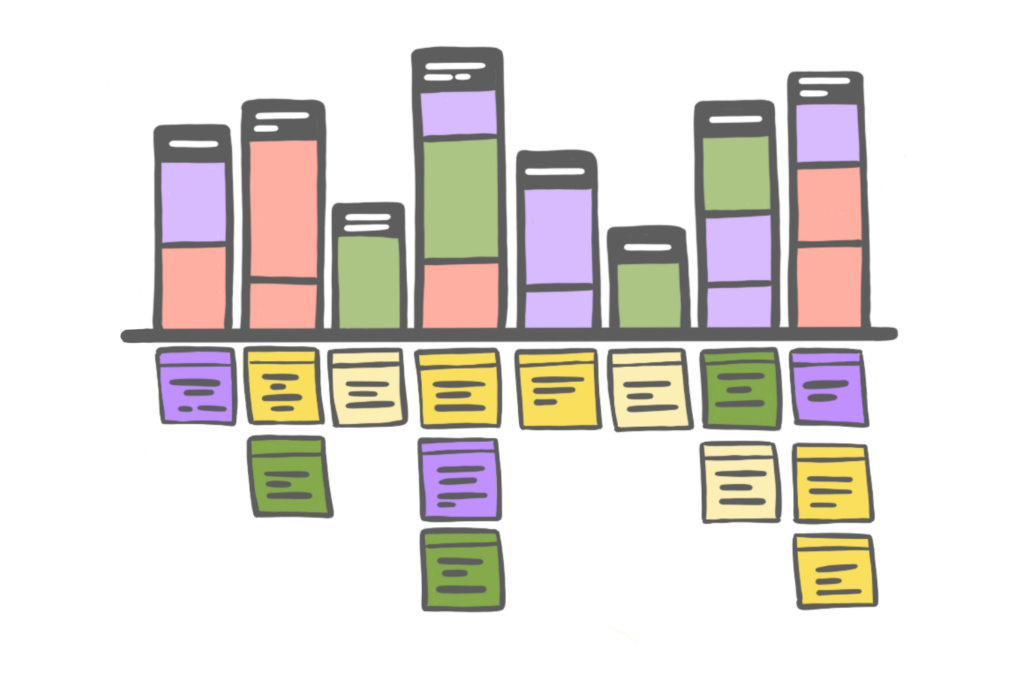Using Mental Model Skylines

About This Course
Prerequisites
- How to conduct listening sessions for data collection
- Demo Listening Sessions
Recommended Knowledge
- Articles about Persuading Stakeholders
- Articles about Empathy
- Articles about Demographic Assumptions
- Watch one of Indi’s latest recorded talks
- Listen to one of Indi’s recent guest appearances on podcasts
Summary
Mental Model Skylines are tools for design strategy & inclusivity. They force you to look at your solutions through the perspective of people trying to accomplish their own purposes.
The other courses in this series cover how to create the diagrams. This is how to use them.
Mental Model Skylines are a powerful way to see where you are making assumptions and decide how to methodologically, consciously, purposefully patch them. In this course, you’ll get to explore many examples of how organizations in software, manufacturing, insurance, higher education, and tech have discovered new clarity and product directions over the past decade. You’ll learn how to layer data from other research on the diagrams. You’ll see how to find gaps and weaknesses, measure progress, and even create scenarios for different thinking styles to help you create multiple ways for people to achieve their purposes.
Organizations use mental model skylines to clarify and categorize the potential paths hidden in front of them.

Above the horizontal line of a mental model skyline is a row of towers (a skyline) of how the people you support think their way through their purpose. Mapped below street level, under each building, is the foundation, containing everything your organization does to support each tower. These diagrams are long-lived; each year you will add a little more knowledge to them. You will see a little further into your future. You can layer data from other research on top of the towers, measure progress toward better support for each thinking styles, and fill in the gaps beneath towers your organization is positioned to support. It’s an incredible way to confidently, systematically discover your potential.
You will learn how to:
- practice the neutral mindset of understanding people as people
- map your org’s capabilities to the towers in a mental model diagram
- look at your products & services through the perspective of people trying to accomplish their purpose
- analyze gaps & weaknesses from the perspective of the people you seek to support
- discover if your support is skewed to one thinking style, and if that is unintentional
- create support for perspectives and approaches you had not considered before
- pivot safely and quickly using the mental model skyline
- measure how well you are truly supporting people
- create a matrix of scenarios for clarity in what “support” really needs to encompass
- mesh with JTBD and Design Thinking, providing richer, longer-lived data to feed process
Course Features (for new format in bundle):
- Videos that don’t require you to look at the screen
- Exercises with answer sheets
- Downloadable diagrams
- Closed captions for each video, along with descriptive transcripts
- Accessible PDFs
- Downloadable transcripts
- Add on Live Group Meetings to do the exercises with Indi
- Live Group Meetings count toward Certification in Problem Space Research
- Membership in Indi’s Slack workspace (no time limit)
Testimonials
I was worried about it being too advanced, but I felt comfortable within the first day. I like that Indi encourages challenging questions. Thank you for making it accessible (and a lot of fun) even for newbies!
— Anna Malysheva, 1-Jul-2020
Your course had a great influence on me personally as an individual who makes daily decisions to build digital products.
I am grateful to Indi for offering her training at a price reachable for people who don’t have US dollar salaries.— Raul Loureiro, 1-Jul-2020
This course brings a enriching perspective to the design principles that we may be using regularly. By putting empathy at the core, it inspires you to understand how to make the existing practices more people-focused. You are able to look at design frameworks and make them more empathetic and meaningful…
— Zulaikha Rahman, 7-Jul-2021
Read more
Frequently Asked Questions
Q: If I have questions about the course content, will Indi answer them for me?
A: Asking a question in the Slack community will give Indi, her team, and many other Slack members a chance to see the question and respond to it.
Q: Do the recordings qualify me for Indi’s Problem Space Certification Program?
A: Not quite. You will also want to join the Live Practice series for each course. In these Live Practice meetings, you get to work on exercises together with Indi and others. This is where we discuss nuances of context and share experiences that help others prepare to conduct their own research. Live Practice meetings give you a chance to double your knowledge and demonstrate your understanding.
Other Languages
Take this course in Chinese through UXOffer:
Take this course in Spanish with Bibiana Nunes:


